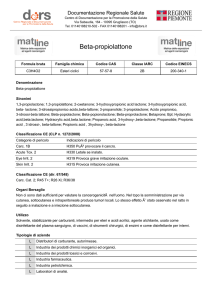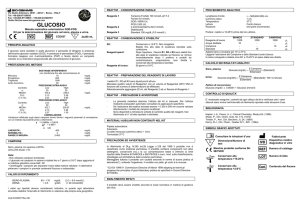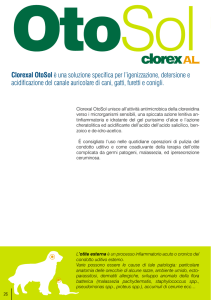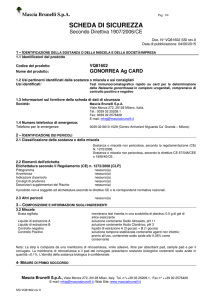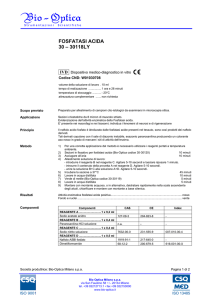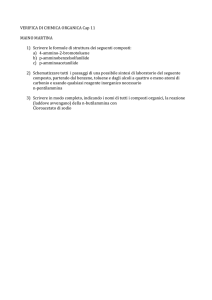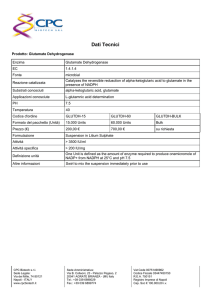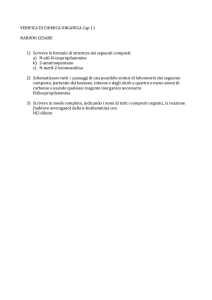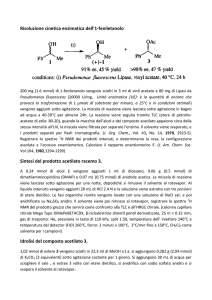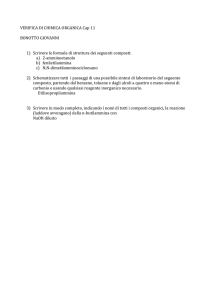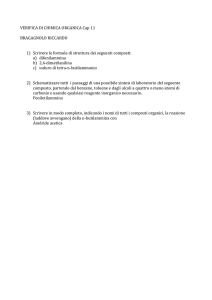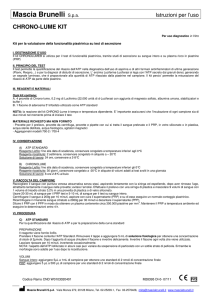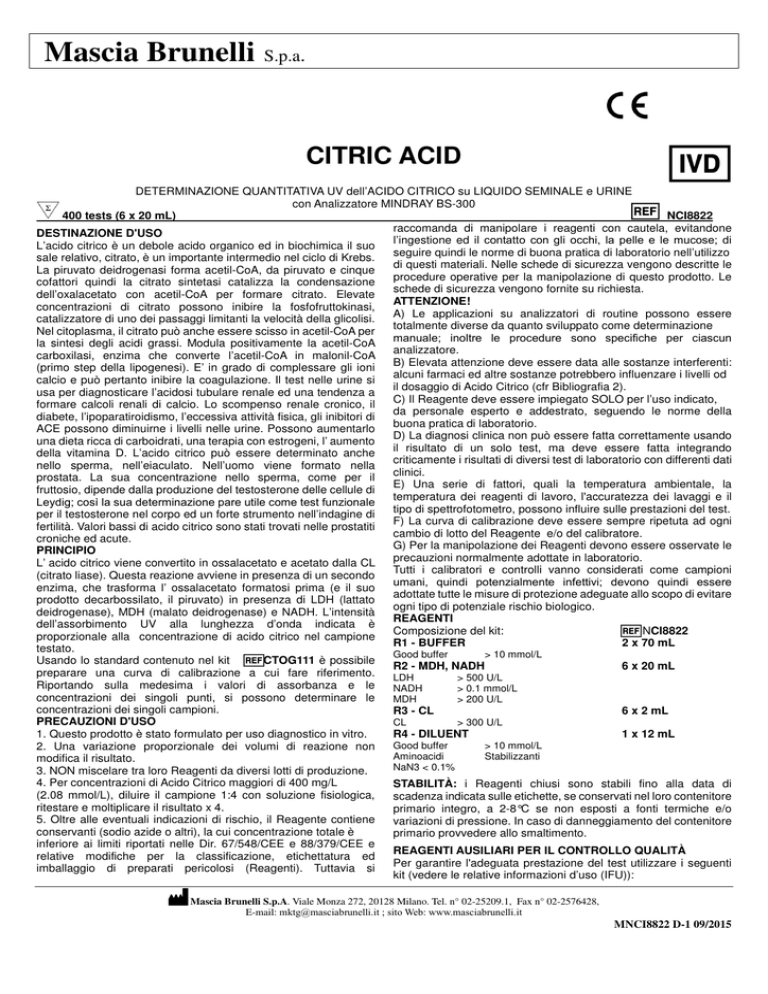
Mascia Brunelli S.p.a.
CITRIC ACID
DETERMINAZIONE QUANTITATIVA UV dell’ACIDO CITRICO su LIQUIDO SEMINALE e URINE
con Analizzatore MINDRAY BS-300
400 tests (6 x 20 mL)
NCI8822
raccomanda
di
manipolare
i
reagenti
con
cautela,
evitandone
DESTINAZIONE D'USO
l’ingestione ed il contatto con gli occhi, la pelle e le mucose; di
L’acido citrico è un debole acido organico ed in biochimica il suo
seguire quindi le norme di buona pratica di laboratorio nell’utilizzo
sale relativo, citrato, è un importante intermedio nel ciclo di Krebs.
di questi materiali. Nelle schede di sicurezza vengono descritte le
La piruvato deidrogenasi forma acetil-CoA, da piruvato e cinque
procedure operative per la manipolazione di questo prodotto. Le
cofattori quindi la citrato sintetasi catalizza la condensazione
schede di sicurezza vengono fornite su richiesta.
dell’oxalacetato con acetil-CoA per formare citrato. Elevate
ATTENZIONE!
concentrazioni di citrato possono inibire la fosfofruttokinasi,
A) Le applicazioni su analizzatori di routine possono essere
catalizzatore di uno dei passaggi limitanti la velocità della glicolisi.
totalmente diverse da quanto sviluppato come determinazione
Nel citoplasma, il citrato può anche essere scisso in acetil-CoA per
manuale; inoltre le procedure sono specifiche per ciascun
la sintesi degli acidi grassi. Modula positivamente la acetil-CoA
analizzatore.
carboxilasi, enzima che converte l’acetil-CoA in malonil-CoA
B) Elevata attenzione deve essere data alle sostanze interferenti:
(primo step della lipogenesi). E’ in grado di complessare gli ioni
alcuni farmaci ed altre sostanze potrebbero influenzare i livelli od
calcio e può pertanto inibire la coagulazione. Il test nelle urine si
il dosaggio di Acido Citrico (cfr Bibliografia 2).
usa per diagnosticare l’acidosi tubulare renale ed una tendenza a
C) Il Reagente deve essere impiegato SOLO per l’uso indicato,
formare calcoli renali di calcio. Lo scompenso renale cronico, il
da personale esperto e addestrato, seguendo le norme della
diabete, l’ipoparatiroidismo, l’eccessiva attività fisica, gli inibitori di
buona pratica di laboratorio.
ACE possono diminuirne i livelli nelle urine. Possono aumentarlo
D) La diagnosi clinica non può essere fatta correttamente usando
una dieta ricca di carboidrati, una terapia con estrogeni, l’ aumento
il risultato di un solo test, ma deve essere fatta integrando
della vitamina D. L’acido citrico può essere determinato anche
criticamente i risultati di diversi test di laboratorio con differenti dati
nello sperma, nell’eiaculato. Nell’uomo viene formato nella
clinici.
prostata. La sua concentrazione nello sperma, come per il
E) Una serie di fattori, quali la temperatura ambientale, la
fruttosio, dipende dalla produzione del testosterone delle cellule di
temperatura dei reagenti di lavoro, l'accuratezza dei lavaggi e il
Leydig; così la sua determinazione pare utile come test funzionale
tipo di spettrofotometro, possono influire sulle prestazioni del test.
per il testosterone nel corpo ed un forte strumento nell’indagine di
F) La curva di calibrazione deve essere sempre ripetuta ad ogni
fertilità. Valori bassi di acido citrico sono stati trovati nelle prostatiti
cambio di lotto del Reagente e/o del calibratore.
croniche ed acute.
G) Per la manipolazione dei Reagenti devono essere osservate le
PRINCIPIO
precauzioni normalmente adottate in laboratorio.
L’ acido citrico viene convertito in ossalacetato e acetato dalla CL
Tutti i calibratori e controlli vanno considerati come campioni
(citrato liase). Questa reazione avviene in presenza di un secondo
umani, quindi potenzialmente infettivi; devono quindi essere
enzima, che trasforma l’ ossalacetato formatosi prima (e il suo
adottate tutte le misure di protezione adeguate allo scopo di evitare
prodotto decarbossilato, il piruvato) in presenza di LDH (lattato
ogni tipo di potenziale rischio biologico.
deidrogenase), MDH (malato deidrogenase) e NADH. L’intensità
REAGENTI
dell’assorbimento UV alla lunghezza d’onda indicata è
Composizione del kit:
NCI8822
proporzionale alla concentrazione di acido citrico nel campione
R1 - BUFFER
2 x 70 mL
testato.
Good buffer
> 10 mmol/L
Usando lo standard contenuto nel kit
CTOG111 è possibile
R2 - MDH, NADH
6 x 20 mL
preparare una curva di calibrazione a cui fare riferimento.
LDH
> 500 U/L
Riportando sulla medesima i valori di assorbanza e le
NADH
> 0.1 mmol/L
concentrazioni dei singoli punti, si possono determinare le
MDH
> 200 U/L
concentrazioni dei singoli campioni.
R3 - CL
6 x 2 mL
PRECAUZIONI D'USO
CL
> 300 U/L
R4 - DILUENT
1 x 12 mL
1. Questo prodotto è stato formulato per uso diagnostico in vitro.
Good buffer
> 10 mmol/L
2. Una variazione proporzionale dei volumi di reazione non
Aminoacidi
Stabilizzanti
modifica il risultato.
NaN3
<
0.1%
3. NON miscelare tra loro Reagenti da diversi lotti di produzione.
4. Per concentrazioni di Acido Citrico maggiori di 400 mg/L
STABILITÀ: i Reagenti chiusi sono stabili fino alla data di
(2.08 mmol/L), diluire il campione 1:4 con soluzione fisiologica,
scadenza indicata sulle etichette, se conservati nel loro contenitore
ritestare e moltiplicare il risultato x 4.
primario integro, a 2-8°C se non esposti a fonti termiche e/o
5. Oltre alle eventuali indicazioni di rischio, il Reagente contiene
variazioni di pressione. In caso di danneggiamento del contenitore
conservanti (sodio azide o altri), la cui concentrazione totale è
primario provvedere allo smaltimento.
inferiore ai limiti riportati nelle Dir. 67/548/CEE e 88/379/CEE e
REAGENTI AUSILIARI PER IL CONTROLLO QUALITÀ
relative modifiche per la classificazione, etichettatura ed
Per garantire l'adeguata prestazione del test utilizzare i seguenti
imballaggio di preparati pericolosi (Reagenti). Tuttavia si
kit (vedere le relative informazioni d’uso (IFU)):
Mascia Brunelli S.p.A. Viale Monza 272, 20128 Milano. Tel. n° 02-25209.1, Fax n° 02-2576428,
E-mail: [email protected] ; sito Web: www.masciabrunelli.it
MNCI8822 D-1 09/2015
Mascia Brunelli S.p.a.
CITRIC ACID
- CI+OX CALIBRATOR liquid
- SUBSTRATE ELEVATED CONTROL lyo
- SUBSTRATE LOW CONTROL lyo
CTOG111
0G3005
0G3006
La curva di calibrazione deve essere sempre ripetuta ad ogni
cambio di lotto del Reagente e/o del calibratore.
PREPARAZIONE DEL REAGENTE DI LAVORO
Dissolvere un vial di R2 - MDH, NADH con 20 mL
di R1 - BUFFER, mescolare gentilmente evitando la formazione di
schiuma. Portare i Reagenti alla temperatura di lavoro prima
dell’uso. Chiudere immediatamente dopo l’impiego. I prodotti
vanno manipolati in modo adeguato, tale da evitare ogni
contaminazione.
L’uso non competente ci solleverà da ogni responsabilità.
STABILITA’ DEL REAGENTE DI LAVORO
Il REAGENTE DI LAVORO - 12 giorni a 2-8°C. ;
- 5 settimane a -20°C. Dopo ricostituzione, NON VANNO
CONGELATI/SCONGELATI per più di una volta.
PREPARAZIONE DEL REAGENTE STARTER
Ricordarsi che questo prodotto è termosensibile (>30°C).
Dissolvere un vial di R3 - CL con 2 mL di R4 - DILUENT, mescolare
gentilmente evitando la formazione di schiuma. Portare i Reagenti
alla temperatura di lavoro prima dell’uso. Chiudere
immediatamente dopo l’impiego. I prodotti vanno manipolati in
modo adeguato, tale da evitare ogni contaminazione.
L’uso non competente ci solleverà da ogni responsabilità.
STABILITA’ DEL REAGENTE STARTER
Il REAGENTE STARTER è stabile:
- 12 giorni a 2-8°C. ;
- 5 settimane a -20°C. Dopo ricostituzione, NON VANNO
CONGELATI/SCONGELATI per più di una volta.
MATERIALI RICHIESTI MA NON FORNITI
Normale attrezzatura da laboratorio.
Micropipette in grado di erogare da 3 a 1000 µL.
Puntali monouso per micropipette.
Provette in vetro trasparente per la diluizione dei campioni.
Soluzione fisiologica, Controlli.
Spettrofotometro od analizzatore automatico di chimica clinica.
CAMPIONI
• Urine;
• Liquido seminale.
Raccolta dei campioni in accordo con CLSI (NCCLS)
(cfr Bibliografia 3).
I campioni possono essere conservati fino a 6 giorni a 2-8°C
(cfr. Bibliografia 1).
PRETRATTAMENTI DEI CAMPIONI
• Usare campioni limpidi; se necessario filtrare.
• Usare campioni a pH neutro; neutralizzare i campioni acidi ad un
pH neutro (max pH ≤ 8.0);
• Campioni proteici vanno deproteinizzati come segue:
- aggiungere acido perclorico (0.33N) 2 mL
al campione
0.2 mL
- miscelare e centrifugare 5 minuti x 5000 rpm
- conservare 1 mL di surnatante
- neutralizzare con 1 mL di idrossido di sodio (NaOH 0.3 N)
- usare direttamente questa soluzione come campione.
- RICORDARE che il fattore di diluizione sarà F = 22; tenerlo in
considerazione per il calcolo
- Se sarà necessario una ulteriore diluizione, ritornare alle
PRECAUZIONI D’USO nota 4).
SMALTIMENTO DEI MATERIALI
Per lo smaltimento dei rifiuti attenersi alle regolamentazioni locali
vigenti.
PROCEDURA ANALITICA su
SPETTROFOTOMETRO MANUALE
• Lunghezza d’onda:
340 nm (334-365 nm)
• Cammino ottico:
1 cm
• Lettura:
contro aria o acqua distillata
• Temperatura:
37°C
• Metodo :
end-point
• Reazione:
8 - 13 minuti
• Rapporto campione/reagente: 1/40/4
Portare i reagenti alla temperatura di lavoro prima dell’uso.
Pipettare nelle provette o nelle cuvette così etichettate:
R/B: bianco reagente; S: Campione
R/B
S
REAGENTE DI LAVORO
1000 µL
1000 µL
Acqua distillata
25 µL
---Campione
---25 µL
Miscelare e incubare per circa 3 minuti a 37°C. Misurare
l’assorbanza AS1 e AR/B1. Poi aggiungere:
REAGENTE STARTER
100 µL
100 µL
Miscelare gentilmente, incubare a 37°C ed aspettare la fine della
reazione. (5-10 minuti). Leggere AR/B2, AST2 e AS2.
Calcolare per il Bianco/Reagente AR/B = (AR/B1 - AR/B2);
Calcolare per il Calibratore AST = ( AST1 - AST2);
Calcolare per il campione AS = (AS1 - AS2).
ATTENZIONE!
Il kit è sperimentato per spettrofotometro manuale e per
sistemi HITACHI, COBAS e MINDRAY.
Le applicazioni su analizzatori automatici possono essere
totalmente
diverse
da
quanto
sviluppato
come
determinazione manuale.
VALORI DI RIFERIMENTO (cfr Bibliografia 1)
Valori normali Acido Citrico:
Adulti MASCHI
115 - 922 mg/24 h
(0.6 - 4.8 mmol/24 h)
Adulti FEMMINE 250 - 1153 mg/24h
(1.3 - 6.0 mmol/24 h)
Poiché i valori normali dipendono dall'età, dal sesso, dalla dieta,
dall'area geografica e da altri fattori, ogni laboratorio deve stabilire
i propri valori normali per questa procedura.
CALCOLO
Usare questa formula generale per calcolare la concentrazione:
(AS – AR/B)
-------------------- x conc. Calibratore (in mg/L) = mg/L di Acido Citrico
(AST – AR/B)
PRESTAZIONI ANALITICHE (validate su MINDRAY BS300)
Le prestazioni del Reagente CITRIC ACID sono state
sperimentate con un analizzatore MINDRAY BS300. I dati, pur
rappresentando le caratteristiche del prodotto, potrebbero variare
Mascia Brunelli S.p.A. Viale Monza 272, 20128 Milano. Tel. n° 02-25209.1, Fax n° 02-2576428,
E-mail: [email protected] ; sito Web: www.masciabrunelli.it
MNCI8822 D-1 09/2015
Mascia Brunelli S.p.a.
CITRIC ACID
per ogni singolo laboratorio e per i diversi analizzatori.
Limitazioni del metodo: non sono conosciute limitazioni.
Linearità del metodo: il test è lineare fino a 400 mg/L
(2.08 mmol/L). Per concentrazioni ≥ 400 mg/L (2.08 mmol/L),
diluire il campione 1:4 con soluzione salina, ripetere la
determinazione e moltiplicare il risultato x 4.
Sensibilità del metodo (LoD) : il limite di sensibilità, ovvero la
concentrazione minima che può essere distinta dallo zero
è 8 mg/L (0.042 mmol/L).
Interferenze: cfr Bibliografia punto 2.
Criterio delle prove di interferenza: recupero ± 10% del valore
iniziale. Non si sono osservate interferenze su campioni con:
- bilirubina totale fino a 40 mg/dL;
- emoglobina fino a 4600 mg/dL;
- lipemia [Intralipid ®] fino a 4000 mg/dL;
- acido ascorbico fino a 50 mg/dL.
Precisione nella serie: determinata su 20 replicati di due
campioni.
I risultati ottenuti sono i seguenti:
Campione
Media (mg/L) ± 2s
CV%
Umano 1
1.71
212 ± 8
Umano 2
0.55
391 ± 4
Precisione tra le serie: determinata per 5 giorni su 20 replicati al
giorno per due campioni.
I risultati ottenuti sono i seguenti:
Campione
Media (mg/L) ± 2s
CV%
Umano 1
1.69
209 ± 8
Umano 2
0.80
398 ± 6
Accuratezza: un gruppo di 20 urine è stato testato con questa
procedura ed usando un reagente simile disponibile in commercio.
Il confronto ha dato i seguenti risultati:
Regressione lineare
y = 0.9894x + 0.005
Coefficiente di correlazione
r = 0.9988 n = 20
BIBLIOGRAFIA
1.Textbook of Clinical Chemistry, Ed. by N.W. Tietz,
W.B. Saunders Co., Philadelphia (1999).
2.Young D.S., Effect of drugs on Clinical Lab. Test,
5th Ed. AACC Press (2000).
3. Tietz Textbook of Clin. Chem. and Molecular Diagnostics, W.B.
Saunders Co., Philadelphia (2012), (119; 154; 581).
CODICE RAMO CND W01010299
Mascia Brunelli S.p.A. Viale Monza 272, 20128 Milano. Tel. n° 02-25209.1, Fax n° 02-2576428,
E-mail: [email protected] ; sito Web: www.masciabrunelli.it
MNCI8822 D-1 09/2015
Mascia Brunelli S.p.a.
CITRIC ACID
400 tests (6 x 20 mL)
CITRIC ACID QUANTITATIVE UV ASSAY on SPERMATIC LIQUID and URINE
with MINDRAY BS-300 Analyzer
INTENDED USE
Citric acid is a weak organic acid and in biochemistry its relative
salt, citrate, is an important intermediate in the Krebs cycle.
Pyruvate dehydrogenase complex forms acetyl CoA, from
pyruvate and five cofactors then citrate synthase catalyzes the
condensation of oxaloacetate with acetyl CoA to form citrate. High
citrate conc. can inhibit phosphofructokinase, catalyst of one of the
rate-limiting steps of glycolysis. Into the cytoplasm, citrate can also
be broken down into acetyl-CoA for fatty acid synthesis. It
modulates positively acetyl-CoA carboxylase, enzyme which
convertes acetyl-CoA into malonyl-CoA (the first step in fatty acid
synthesis). It is able to chelate calcium ions, can therefore inhibits
coagulation.
The test in urine is used to diagnose renal tubular acidosis and a
tendency to form calcium kidney stones. Chronic kidney failure,
diabetes, hypoparathyroidism, excessive muscle activity, ACE
inhititors may decrease urine levels.
May increase it an high carbohydrate diet, estrogen therapy,
increase of vitamin D.
Citric acid may also be determining citric acid in the sperm, in the
ejaculate. In man it is formed in the prostate.
Its concentration in the sperm, as for fructose, depends on the
testosterone production of the Leydig’s cells; so the citric acid
determination appear useful as a functional test for testosterone
level in the body and a strong instrument in fertility investigations.
Low citric acid values have been found in acute or chronic
prostatitis.
PRINCIPLE
The Citric acid is changed in oxalacetate and acetate by CL (citrate
lyase). This reaction is helped by a secondary one, who transforms
the oxalacetate originated before (and its decarboxilated product,
pyruvate) in the presence of LDH (lactate dehydrogenase), MDH
(malate dehydrogenase) and NADH.
The intensity of the UV-colour at this wavelength is proportional to
the concentration of Citric acid in the tested sample.
Using the standard contained in the kit
TOG111 it is possible
to prepare a Calibration Curve to refer. Plotting on the Calibration
Curve absorbance values and concentration for each single
sample, may be determined the concentration of each sample
PRECAUTIONS FOR USE
1. This product has been formulated for in vitro diagnostic use.
2. A proportional variation of the reaction volumes does not change
the result.
3. DO NOT mix Reagents from different Production lots.
4. For concentration of Citrc Acid higher than 400 mg/L (2.08
mmol/L), dilute the sample 1:4 with saline solution, repeat the
determination and multiply the result by 4.
5. In addition to the possible risk indications, the Reagent can
contain preservatives (as sodium azide or others), which total
concentration is lower than the limits mentioned in Dir. 67/548/CEE
e 88/379/CEE and following modifications regarding classification,
NCI8822
labelling and packaging of dangerous preparations (Reagents).
However it is recommended to handle the reagents carefully,
avoiding ingestion and contact with eyes, mucous membranes and
skin; to use reagents according to good laboratory practice. On the
material safety data sheet are detailed
the operating procedures for the manipulation of this product.
Material safety data sheet should be supplied on request.
ATTENTION!
A) Applications on routine analyzers may be totally different from
what developed as manual determination; in addition the
procedures are specific for each analyzer.
B) Very deep attention must be given to interfering substances:
certain drugs and other substances are able to influence levels of
Citric Acid (see References 2).
C) The reagent must be used ONLY for the intended destinations,
by expert and trained people and in according to good laboratory
practice.
D) The clinical diagnosis cannot be done correctly using the result
of only one test, but have to be done integrating critically the results
of different laboratory tests and clinical data.
E) A lot of factors, as ambient temperature, the working reagent
temperature, wash accuracy and the type of spectrophotometer,
may affect the tests performances.
F) The calibration curve has to be always repeated at each change
of the lot of the Reagent and/or calibrator.
G) All the precautions normally used in the laboratory must be
respected for reagents handling.
All the calibrators and controls must be considered as human
sample, so potentially infectious; all the protection actions must be
applied to avoid any potential biological risk.
REAGENTS
Components of the kit:
R1 - BUFFER
Good buffer
> 10 mmol/L
R2 - MDH, NADH
LDH
NADH
MDH
> 500 U/L
> 0.1 mmol/L
> 200 U/L
CL
> 300 U/L
R3 - CL
R4 - DILUENT
Good buffer
Aminoacids
Stabilizers
NaN3 < 0.1%
NCI8822
2 x 70 mL
6 x 20 mL
6 x 2 mL
1 x 12 mL
> 10 mmol/L
STABILITY: the Reagents are stable up to the expiry date
mentioned on the labels, stored at 2-8°C, if closed and kept in their
intact primary container; if not exposed to heat sources and/or
pressure variations.
In case of damaging of the primary container organize the waste
disposal.
Mascia Brunelli S.p.A. Viale Monza 272, 20128 Milano. Tel. n° 02-25209.1, Fax n° 02-2576428,
E-mail: [email protected] ; sito Web: www.masciabrunelli.it
MNCI8822 D-1 09/2015
Mascia Brunelli S.p.a.
CITRIC ACID
AUXILIARY REAGENTS FOR QUALITY CONTROL
To grant the right performances use following kits (see the relative
information for use (IFU)):
- CI+OX CALIBRATOR liquid
- SUBSTRATE ELEVATED CONTROL lyo
- SUBSTRATE LOW CONTROL lyo
CTOG111
OG3005
OG3006
The calibration curve has to be always repeated at each change of
the lot of the Reagent and/or calibrator.
PREPARATION OF THE WORKING REAGENT
Dissolve a vial of R2 - MDH, NADH with 20 mL of R1 - BUFFER,
mix gently avoid foaming.
Let the reagent reach the room temperature before use.
Close immediately after handling.
The Reagents have to be used correctly, to avoid contamination.
An incompetent handling relieves us from any responsibility.
STABILITY OF THE WORKING REAGENT
The WORKING STARTER is stable:
- 12 days at 2-8°C.;
- 5 weeks at -20°C, when frozen. After reconstitution FREEZE only
ONE TIME, DO NOT REPEAT FREEZING.
PREPARATION OF THE WORKING STARTER
Rem that this product is temperature sensitive (>30°C).
Dissolve a vial of R3 - CL with 2 mL of R4 - DILUENT, mix gently
avoid foaming.
Let the reagent reach the room temperature before use.
Close immediately after handling.
The Reagents have to be used correctly, to avoid contamination.
An incompetent handling relieves us from any responsibility.
STABILITY OF THE WORKING STARTER
The WORKING STARTER is stable 12 days at 2-8°C.
MATERIAL REQUIRED BUT NOT PROVIDED
Normal laboratory equipment.
Micropipettes to deliver from 3 to 1000 μL.
Disposable micropipettes tips .
Transparent glass tubes for sample dilution.
Saline solution.
Spectrophotometer or automatic analyzer for Clinical Chemistry.
SAMPLES
• Urine.
• Spermatic liquid.
Samples collection incompliance with CLSI (NCCLS)
(see References 3).
The sample can be stored at 2-8°C, up to 6 days.
(see References 1).
SAMPLES PRETREATMENT
• Use limpid samples; If necessary, filter the samples.
• Use samples at neutral pH; neutralize the Acidic Samples at a
neutral pH (max pH ≤ 8.0).
• Proteic samples may be required deproteinization as follows:
- add perchloric acid (0.33N) 2 mL
to the sample
0.2 mL
- mix and centrifuge 5 minutes x 5000 rpm
- keep 1 mL of the supernatant
- neutralize with 1 mL sodium hydroxide (NaOH 0.3 N)
- use directly this solution as sample.
- REM that the Dilution Factor will be F = 22; keep in mind for
the Calculation
- if it will be need further dilutions, please return to PRECAUTIONS
FOR USE note 4).
WASTE DISPOSAL
Observe all federal, state and local environmental regulations for
waste disposal.
ANALYTICAL
PROCEDURE
ON
MANUAL
SPECTROPHOTOMETER
• Wavelength:
340 nm (334 - 365 nm)
• Pathlength:
1 cm
• Reading:
against air or distilled water
• Temperature:
37°C
• Method:
end-point
• Reaction:
8 - 13 minutes
• Sample/reagent:
1/40/4
Let reagents reach the working temperature before use.
Pipette in a test tube or cuvette so labelled:
R/B: Reagent Blank, S: Sample
R/B
S
WORKING REAGENT
Distilled water
1000 µL
1000 µL
25 µL
----
Sample
---25 µL
Mix and incubate for about 3 minutes at 37°C. Measure the
absorbance AS1 and AR/B1. Then add:
WORKING STARTER
100 µL
100 µL
Mix carefully, incubate at 37°C and wait the end of the reaction
(5-10 minutes). Read AR/B2, AST2 and AS2.
Calculate for the Reagent/Blank AR/B = (AR/B1 - AR/B2);
Calculate for the Calibrator AST = (AST1 – AST2);
Calculate for the Sample AS = (AS1 – AS2).
ATTENTION!
The kit is tested for a manual spectrophotometer and for
HITACHI, COBAS and MINDRAY systems. The applications on
automatic analysers could be completely different by what
has been developed as manual determination.
REFERENCE VALUES (see References 1)
Normal Values Citric Acid:
Adults MALES
115 - 922 mg/24 h (0,6 - 4,8 mmol/24 h)
Adults FEMALES 250 - 1153 mg/24h (1,3 - 6,0 mmol/24 h)
Since the normal values depend on age, sex, diet, geographic area
and other factors, each laboratory should establish its own normal
values for this procedure.
CALCULATION
Use this general formula to calculate the concentration:
(AS – AR/B)
-------------------- x conc. Calibrator (in mg/L) = mg/L of Citric Acid
(AST – AR/B)
ANALYTICAL PERFORMANCES
(validate on MINDRAY BS300)
The performances of the Reagent CITRIC ACID have been tested
Mascia Brunelli S.p.A. Viale Monza 272, 20128 Milano. Tel. n° 02-25209.1, Fax n° 02-2576428,
E-mail: [email protected] ; sito Web: www.masciabrunelli.it
MNCI8822 D-1 09/2015
Mascia Brunelli S.p.a.
CITRIC ACID
with a MINDRAY BS300 analyzer. The data, while representing the
characteristics of the product, could be different for each laboratory
and for different analyzers.
Method Limitations: are not know limitations.
Method Linearity: the test is linear up to 400 mg/L
(2.08 mmol/L). For concentrations ≥ 400 mg/L (2.08 mmol/L), it is
recommended to dilute the sample 1:4 with saline solution, test
again and multiply the result x 4.
Method Sensitivity (LoD): the sensitivity limit, that is the
minimum concentration that can be distinguished by zero,
is 8 mg/L (0.042 mmol/L).
Interferences: see References 2.
Interference test criterion: recovery ± 10% of initial value. No
interference found on samples with:
- total bilirubin up to 40 mg/dL;
- haemoglobin up to 600 mg/dL,
- lipemia [Intralipid ®] up to 4000 mg/dL;
- ascorbic acid up to 50 mg/dL.
Within-run Precision: determined on 20 replications of 2
samples.
The results obtained are following:
Sample
CV %
Mean (mg/L) ± 2s
Human 1
1.71
212 ± 8
Human 2
0.55
391 ± 4
Run-to-run Precision: determined for 5 days with 20 replications
for each days, for two samples.
The results obtained are the following:
Sample
CV %
Mean (mg/L) ± 2s
Human 1
1.69
209 ± 8
Human 2
0.80
398 ± 6
Accuracy: a group of 20 urine has been tested using this
procedure and using a similar reagent available on the market. The
comparison gave these results:
Linear regression equation
y = 0.9894x + 0.005
Correlation coefficient
r = 0.9988 n = 20
REFERENCES
1.Textbook of Clinical Chemistry, Ed. by N.W. Tietz,
W.B. Saunders Co., Philadelphia (1999).
2.Young D.S., Effect of drugs on Clinical Lab. Test,
5th Ed. AACC Press (2000).
3. Tietz Textbook of Clin. Chem. and Molecular Diagnostics, W.B.
Saunders Co., Philadelphia (2012), (119; 154; 581).
Mascia Brunelli S.p.A. Viale Monza 272, 20128 Milano. Tel. n° 02-25209.1, Fax n° 02-2576428,
E-mail: [email protected] ; sito Web: www.masciabrunelli.it
MNCI8822 D-1 09/2015

